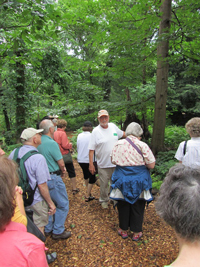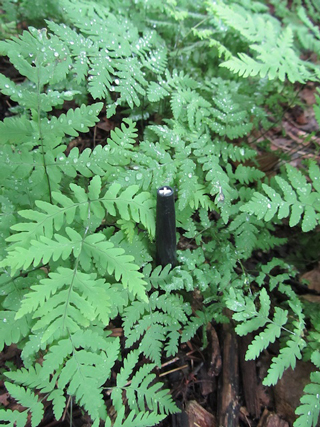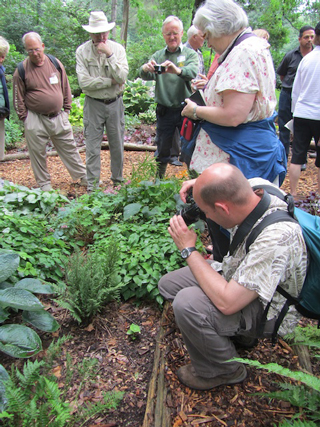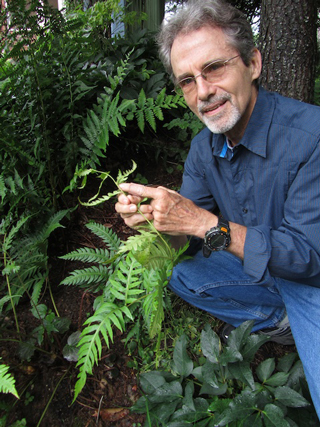Human Flower Project
Fern Fetish
Plant experts from the U.S. and the U.K. unite to tour “the crossroads of sporangia,” otherwise known as Kentucky. Thank you, Allen!
 Ralph Archer leads a bi-national tour of Whitehall’s woodland garden, named for him, Louisville, KY
Ralph Archer leads a bi-national tour of Whitehall’s woodland garden, named for him, Louisville, KY
Photo: Allen Bush
By Allen Bush
Sarah Palin, the revisionist expert on Paul Revere’s warning, never saw the British coming, yet the occasional elected official and non-stop self-promoter needn’t worry about foreign invaders, at least not these: Royal subjects with a fetish for ferns, members of the British Pteridological Society, came to Louisville, Kentucky, near the summer solstice, heeding a call to join their counterparts from the American Fern Foundation for a two-week tour of southeastern natural woodlands and shade gardens. You’ve never seen a busload so excited about sporangia.
According to Ralph Archer, the Louisville tour guide, Kentucky is a happy hunting ground for hardy ferns. He was responsible for planting host Whitehall’s fern collection – now called the Ralph Archer Woodland Garden at Whitehall. (Mike Hayman, Leslie Pancratz and a devoted group of nine Master Gardeners keep the garden in fine shape now.)
Kentucky is at fern crossroads of the United States – the nexus between the flora of the east and west and north and south.
The garden visitors, slowed by the weight of a humid morning, didn’t need to be told that it was hot at these crossroads. But they did miss the boat on some beautiful blooming plants.
Did they see the hedging Hydrangeas in various shades of white, pink and blue? Hydrangea paniculata ‘Tokyo Delight,’ a lacecap form with blue and white blooms was exceptional. (I suspect someone at Whitehall has dosed the soil to lower the pH to a more acidic range to get the blue coloring. I sit on a limestone outcrop, not far away, and the pH is a sweet 7.2. This would turn the blooms a pinker shade.) It’s a shame the visitors missed the bright red Crocosmia ‘Lucifer,’ and the gold shades of Alstroemeria ‘Sweet Laura’ and Coreopsis ‘Zagreb’ in the sunny long border.
 Gymnocarpium dryopteris in the Whitehall woodland garden
Gymnocarpium dryopteris in the Whitehall woodland garden
Photo: Allen Bush
The folks had a focus on ferns and were herded, instead, down the hill past the ten-foot tall flowering oak leaf Hydrangeas that had just passed from white to the palest green. (Wait a day and the pastel beauty fades away.) A large sweep of the low-growing, pink-purple flowering, Astilbe chinensis var. pumila and the tall white wands of the fairy candles Actaea (Cimicifuga) racemosa went begging for attention. The large leaves on the Chinese Jack-in-the pulpit, Arisaema ringens, drew a crowd, but briefly.
Bright red stems on a short Asian Solomon’s seal, Polygonatum Jingugi form stopped me dead in my tracks. The foliage on Epimediums, Hepaticas and the giant Solomon’s seal might have caught someone’s eye in April but this was June. Unable to hide his allegiance, and weary of unremarkable Hosta blooms, British author and fern expert
“ title=” martin rickard”>Martin Rickard was heard up ahead, doling-out theology: “Remove the Hostas and put in more ferns.”

Mary Anne Thornton and Ritchie Steffen admire a fallen osage orange tree, “companion plant” for ferns
Photo: Allen Bush
Chalk one up for seedless vascular plants! Hanging on Rickard’s prophetic words, others nodded approvingly before moving down the bark mulch path to a massive tree trunk – now horizontal—in slow decay. An osage orange was strategically located to look like a natural part of the forest floor—fit for ferns. “That’s a marvelous piece of wood. I’d like to take it home, “ dreamed author Sue Olsen.
 Richie Steffen photographs a possible fern hybrid between the Japanese lady ferns ‘Lady in Red’ and ‘Ghost’—Whitehall Gardens, Louisville, KY
Richie Steffen photographs a possible fern hybrid between the Japanese lady ferns ‘Lady in Red’ and ‘Ghost’—Whitehall Gardens, Louisville, KY
Photo: Allen Bush
I got covetous in a bad way, too. I wanted to take home a couple of lady ferns. ‘Ocean’s Fury’ and an interesting suspected cross between the cultivars ‘Lady in Red’ and ‘Ghost’ looked very tempting…I’ll have to look for commercial sources someday. And I’d never seen the diminutive Gymnocarpium dryopteris. It made a very fine low-growing groundcover.
There was a familiar looking fern growing luxuriously on a nearby old stump. (I wonder if I have room for a “stumpery” at home…?) I thought the fern might be Polypodium vulgare. Rickard spoke-out and said it might actually be a homegrown species, the newly recognized Polypodium appalachianum. Newly recognized? Isn’t this a bit of taxonomic smoke and mirrors? This fern was no newcomer, even though there was only a bare bones difference with Polypodium vuglare. But botanists decided there was a distinction – niggling or not – and the Appalachian rock cap fern got split off into a brand new species.
After a sweltering hour-long dose of the Ohio Valley, everyone wandered indoors to the air-conditioned comfort of Whitehall for lunch. Dick Lighty’s lecture followed: “The Fabulous Fern Fetish.” (The pteridophiles could expect lots more heat, humidity and heartburn in the days ahead as they traveled to Georgia, Alabama North Carolina, South Carolina and Tennessee. A bus tour of the Southeast wouldn’t be complete—or survivable—without regular breaks for barbeque, fried chicken, meatloaf, coleslaw, mashed potatoes, hush puppies and iced tea.)
 Dick Lighty, founder of the Longwood Graduate Program in Public Garden Administration, spoke about his lifetime work in fern genetics.
Dick Lighty, founder of the Longwood Graduate Program in Public Garden Administration, spoke about his lifetime work in fern genetics.
Photo: Allen Bush
Lighty’s slide presentation was a look back at a love affair with ferns. At age 10, the precocious young boy knew he wanted to become a plant geneticist. A “fern foray” was his destiny. As a teenager, he discovered many of the 53 native ferns of Essex County, New Jersey, near his family’s new home. Later he would jump into the phylogeny of Osmunda (named by Linnaeus for either for a Nordic god or a Saxon hero) and be able to key-out a few fertile pinnae at the apex of a sterile frond.
Lighty’s distinguished career took him to Longwood Gardens in 1960 where he directed research. In 1967, he founded the Longwood Graduate Program in Public Garden Administration at the University of Delaware. And from 1983, until his retirement in 1998, he was the founding director of Mt Cuba Center for the Study of Piedmont Flora.
Lighty has a love for gardens and the wild. He and his wife Sally tended seven acres of woodland and sunny, open gardens for forty-six years. And he has traveled to five continents in search of wild species and cultivated plants. He can lay claim to the introduction of over 30 species and cultivars to gardens.
Where have I been all these years? I’ve been gardening for four decades but, somehow, never caught the fern bug. My plant hunting colleagues – Frank Bell, Pierre Bennerup, Linda Guy, Hans Hansen, Dan Hinkley, Paul Jones, Scott McMahan and Pam Spaulding—were all fern friendly. They got it. I had the blinders on. I ignored their excitement. I was only able to focus on “more evolved” species of flowering perennials like Sedums, Chinese mayapples and Jack-in-the pulpits.
 Ozzie Johnson of Georgia admired progeny of his Woodwardia unigemmata fern, now growing in Allen Bush’s Louisville garden
Ozzie Johnson of Georgia admired progeny of his Woodwardia unigemmata fern, now growing in Allen Bush’s Louisville garden
Photo: Allen Bush
Ozzie Johnson, another one of the China plant collectors, struck pay dirt when he stumbled on gorgeous fern species in 2005 near the town of Taoyuan in northern Sichuan near the Gansu border. I wasn’t on that trip, but probably wouldn’t have paid much attention to Woodwardia unigemmata, anyway. But when I saw this specimen in his beautiful Marietta, Georgia, garden in 2010, I came to my senses. I had to have one. And, of course, Ozzie was happy to share a piece. By the time of my visit to Ozzie’s garden, I was a seeker of more fern understanding, but my epiphany came at Whitehall. Ralph Archer, Dick, Lighty, Sue Olsen and Martin Rickard, and busload of fern geeks made me see the light through the filtered shade of a woodland garden—two miles from home.
That light shines on a rich past and a lethal present. Seedless vascular plants include ferns and fern allies like club mosses; they’ve been around for a long, long time—reproducing by sporangia (spores) on fronds or modified leaves called sporophylls for the past 400 million years. Kentucky’s extensive coal seams were formed from fossilized fern deposits. Seventy-six native taxa of pteridophytes (ferns and their allies) exist today across the Bluegrass state. Tree ferns, giant lycopods and huge horsetails slipped through the cracks and disappeared over time.
But in the blink of evolutionary time – since the 1960s – precious mountaintops, principally in eastern Kentucky and West Virginia, have been blown to pieces to extract fuel-rich coal that started life as ferns. A diverse woodland ecology—including fern habitats—is being lost. Valleys and streams are often filled-in with what’s leftover after the coal is removed – “ the overburden.” My Kentucky started with ferns. What a burden to bear.

